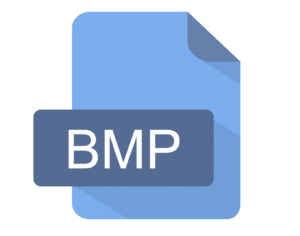What is a BMP image file?
A BMP is a bitmap image file format to store monochrome and colour images. It was originally created by Microsoft for computers running Windows.
It was primarily designed for Window platforms although it also works on other platforms. It is not supported in Web browsers.
The file name extension for BMP files is: .bmp
Here are some other questions about BMP you might also want to ask. If you have any other questions, please feel free to contact us and we will try to answer.
What is a BMP file used for?
BMP is used for storing bitmap images. It is commonly used on Windows systems but less so on Linux, Mac and other platforms. It does not compress the data (unlike PNG or JPG) so it creates much larger files and it is not supported by web browsers.
So there are better options (on Windows and other platforms). So it is less popular than PNG, JPEG, TIFF or new standards such as HEIC or WebP.
Other uses of BMP files include:
- Printing detailed full-color photos that require lossless image data for precision.
- Creating icons, screen captures, and bitmap graphics in Windows environments.
- Use in legacy or internal applications requiring compatibility with Windows bitmap standards.
- Displaying images on Windows and OS/2 systems without needing extra codecs or plugins.
Why is BMP popular?
Microsoft used BMP as the default for several application in Windows. So, many people are using Heic without even realising it.
How can I learn about BMP?
You read up on the BMP file format here.
Is it possible to convert BMP to JPG?
Yes. You can convert BMP to JPG and JPG to BMP. You will lose any transparency if you convert from PNG and may need to remember that BMP offers less compression than JPG.
Is it possible to convert BMP to PDF?
Yes. You will need to print the BMP (most printers offer a print as PDF), export as PDF in a graphics package such as Mac Preview or use a third party tool such as our JDeli library. JDeli is the best pure Java image library for performance and efficiency.
How to open BMP files in Java?
ImageIO (the built-in Java Image library) includes support for BMP images.
There are several commercial BMP solutions available. Our JDeli Java image library also has BMP support and allows you to read, write and display BMP files.
Are you a Java Developer working with Image files?
// Read an image
BufferedImage bufferedImage = JDeli.read(avifImageFile);
// Write an image
JDeli.write(bufferedImage, "avif", outputStreamOrFile);// Read an image
BufferedImage bufferedImage = JDeli.read(dicomImageFile);// Read an image
BufferedImage bufferedImage = JDeli.read(heicImageFile);
// Write an image
JDeli.write(bufferedImage, "heic", outputStreamOrFile);// Read an image
BufferedImage bufferedImage = JDeli.read(jpegImageFile);
// Write an image
JDeli.write(bufferedImage, "jpeg", outputStreamOrFile);
// Read an image
BufferedImage bufferedImage = JDeli.read(jpeg2000ImageFile);
// Write an image
JDeli.write(bufferedImage, "jpx", outputStreamOrFile);
// Write an image
JDeli.write(bufferedImage, "pdf", outputStreamOrFile);
// Read an image
BufferedImage bufferedImage = JDeli.read(pngImageFile);
// Write an image
JDeli.write(bufferedImage, "png", outputStreamOrFile);
// Read an image
BufferedImage bufferedImage = JDeli.read(tiffImageFile);
// Write an image
JDeli.write(bufferedImage, "tiff", outputStreamOrFile);
// Read an image
BufferedImage bufferedImage = JDeli.read(webpImageFile);
// Write an image
JDeli.write(bufferedImage, "webp", outputStreamOrFile);
What is JDeli?
JDeli is a commercial Java Image library that is used to read, write, convert, manipulate and process many different image formats.
Why use JDeli?
To handle many well known formats such as JPEG, PNG, TIFF as well as newer formats like AVIF, HEIC and JPEG XL in java with no calls to any external system or third party library.
What licenses are available?
We have 3 licenses available:
Server for on premises and cloud servers, Distribution for use in a named end user applications, and Custom for more demanding requirements.
How does JDeli compare?
We work hard to make sure JDeli performance is better than or similar to other java image libraries. Check out our benchmarks to see just how well JDeli performs.

